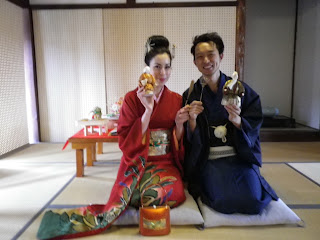About two years ago, my friend from Kyushu got engaged and she showed me her “YUINO” engagement gifts displayed in her family’s tatami room. Ever since then I was fascinated by this old tradition and the symbolism of each item presented. I knew that the yuino ceremony is not common nowadays, and that mainly very traditional families in rural areas still host this event for their children. When Seisuke and I first got engaged, I did not expect that we would do that (especially because it is a ceremony for the joining of two families and my family would obviously not be present) BUT I wanted the yuino gifts so badly!!! They are all handmade out of a special cord called “Mizuhiki”. The cord looks like thin colored wire and is wrapped, twisted, and braided to form various shapes. The handmade decorations are very expensive (hundreds to thousands of dollars!!!!) and most Japanese families who have them only display them during their engagement and then keep them in storage for the rest of their lives (which I think is such a waste!). So I asked Seisuke if there was any place in Japan that sold used ones (I mean, they are only displayed once so it’s not like they would be dirty!) or if anyone in his family had some lying in their closets. WELL, much to my luck, his older sister had received them from her husband’s family and did not want them anymore! So his mom decided that she wanted to present them to me and have a family engagement party! I was thrilled! I had been dreaming about these shiny delicate treasures ever since I laid eyes on them and now I would actually have my own! This is something that I hope to display in our new home and pass down to my children someday.
Anyway, since we were going to have an engagement party, I asked if his older sisters had any kimono that I could wear for this event (kimonos are often worn when girls turn 20 and for college graduation so it is common for families to keep at least one within the family). Unfortunately his sisters did not own any kimonos. But his mom was able to borrow a full set from her friend who has a daughter who is as tall as me! I was very lucky that I could borrow her kimono because buying (or even renting) kimono sets cost thousands of dollars! Seisuke was able to wear his grandpa’s kimono set so we could take some engagement pictures together.
Seisuke’s mom and her friend helped put the kimono on me. Let me tell you, it took a long time to get everything on and it was very tiring but the end result was worth it! :) After we got dressed, we took some pictures in front of our house and then walked over to his grandpa’s house where the yuino presents were waiting.
 |
| Standing in front of our future home! |
 |
| Walking from our house to Seisuke's grandpa's house |
 |
| It started to rain a little bit! |
 |
| Checking out the Yuino presents! |
 |
| Learning about the envelopes! |
 |
| Plum, bamboo, and pine trees in the back. Turtle and Crane on the sides. |
The three trees are known as “sho, chiku, bai” (pine, bamboo, and plum trees) and all represent strength and longevity for marriage. I love the symbolism of these trees: all three trees live throughout winter, showing that couples can overcome any hardships they may face. The pine tree, like an evergreen, lives for hundreds to thousands of year, representing a long life together. The bamboo tree is flexible and can bend with the wind without breaking, showing that marriage is about compromise and resilience. The plum tree is the first to blossom in the winter, symbolizing hope and new beginnings.
The decorations on the far right and far left are a crane and a turtle, which are both considered mythical creatures in Japan. Cranes have one partner for life and, in old Japanese stories, are said to live thousands of years, representing loyalty, commitment, and longevity. Turtles represent longevity and good fortune. The dolls in the middle are supposed to represent the married couple, showing that they will grow old together.
Gifts of dried seaweed and katsuo fish were also presented (I think to represent health and fertility!). And traditionally there are several different envelopes of money with different categories written on them (such as food, clothing, furniture, etc.) for the couple to start their new lives together. Traditionally Japanese like to give monies in odd numbers, such as $100, $300, $500, etc. because even numbers can be split, well, evenly, and they believe that new couples should make decisions about spending money together.
After looking at all the lovely gifts, we took some pictures outside and then Seisuke’s dad drove us to a local shrine so that we could pray together.
When we returned home, it was time for lunch so I took off the beautiful red kimono and changed into his mom’s machine washable kimono. She also let me wear this hand-knit sweater to protect my sleeves from getting dirty while I ate. We had a great feast of “temakizushi,” aka, hand rolls. It was fun to choose different toppings to make individual bite-sized sushi.
After lunch, Seisuke and I went through the different rooms in the house and decide which colors to paint or wallpaper the walls. We can't wait to post before and after pics of our new home!













































